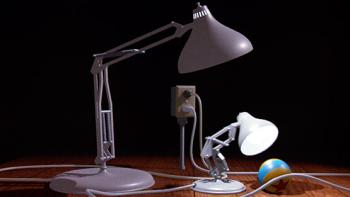The Fabulous Disney Babe
Page 2 of 2
Something pivotal happened in 1977, when he was at CalArts: he stood in line for six hours at the Chinese Theatre to see a new film called Star Wars. He loved the anticipation, and how it entertained everyone in the theatre, young and old. John thought: "Animation can do this!" Early tests for Tron were going on at Disney at that time as well. John was working on Mickey's Christmas Carol, but was amazed at the technology of Tron. "Come on, this is amazing! It's like a steadicam, with the ability to go in and around objects!" He partnered with friend and fellow animator Glen Keane, now considered a master of the art, and they did a thirty-second test. This was before Michael Eisner, Frank Wells and Jeffrey Katzenberg woke up Disney Animation as a force to be reckoned with in the early eighties, so those in charge of Animation at the time told the duo that the only way they'd be interested in computer animation was if the computer made the animation cheaper and faster. Walt Disney was always striving for more and better; this was the next step from the Multiplane camera, a Disney invention which revolutionized the animated filmmaking process. Those who followed were more interested in the bottom line than in pushing the envelope.
Ed Catmull over at Lucasfilm was, however, interested in this new medium. At that time, all filmmaking was pretty much following what D.W.Griffith had pioneered, but with sound and color. This was the next step. There are three good reasons to add this new technology: To develop a digital editing system, to get Sound effects completely computerized, and to composite levels together digitally, not optically. Today, there isn't a single major film created without the computer breakthroughs pioneered by Catmull and his team. Filmmakers haven't used optical printers in a decade.
Ed brought John up from Disney, and in 1986 the company became Pixar. Steve Jobs of Apple Computers bought the company from Lucas. At the time, it was a software company, not a film studio. "Let's do a film for Siggraph!" Ed said. Siggraph is the big computer show (www.siggraph.org) where new and fabulous achievements are trotted out every year.
John had been experimenting with animation, and Ed, who invented the texture mapping method, started modeling the Luxo lamp on John's desk. John got out his ruler and started learning how to model with the lamp as well. Bill Reeves developed a shadowing system - before then, computers couldn't create shadows. The animator would have to copy the image, flatten it, stretch it, and color it black. It never looked quite perfect. John's friend Tom Porter had a new baby son, and John was watching him: he couldn't touch the top of his head, because a baby's body proportions are so different from those of an adult. John looked at the scale of his Luxo lamp and wondered: what would a baby lamp look like? Would it, like a human, have a bigger head in proportion to its body? The light bulb, of course, would be the same size, as you buy that in a hardware store and screw it in.

(c) Pixar
Luxo Jr. debuted at the Dallas Siggraph convention in 1986, to a tremendous reception. You have to understand, John explained: there was no such thing as off-the-shelf computer animation software. All of the computer animation at that time was being done by the same people who created the software. That is tantamount to living in a world where all of the paintings are done by the chemists who formulate the paint. Or all of the pencil animation by the woodsmen who cut down the trees!
People had fun trying to wrap their minds around the concept: "This picture was made with a computer. This picture does not exist." And they were Bad Art, John added: crystal balls over checkerboards and similar monstrosities. At Lucas, they saw it not as something with which to create a new art form, but as tools for filmmaking.
John looked around at those who worked with him. "They're all PhD's, but they can't make something come alive with pure movement like I can." Thanks to his great professors at CalArts, and great animators at Disney who mentored him, namely Frank Thomas and Ollie Johnston, he could do what no one else there could. He sat next to his coworkers and brainstormed with his artist's eye: "Hey, if you can do *that*, can you do *this*?" he pushed the envelope. "Art challenges technology," he said, "and technology inspires the art.
In the next part: "What software?"
-- Fab
Discuss It
Related Links
-- Michelle Smith
Michelle Smith can be reached using the Talkback form below or by emailing her at [email protected].
The Fabulous Disney Babe's column is posted every Friday and when ever else she has something to say. For more on Michelle's background, see her first column. She also offers The Fabulous Tour: Disneyland Secrets and Stories. Click here for more information.
The opinions expressed by our Michelle Smith, and all of our columnists, do not necessarily represent the feelings of LaughingPlace.com or any of its employees or advertisers. All speculation and rumors about the future plans of the Walt Disney Company are just that - speculation and rumors - and should be treated as such.
-- Posted January 27, 2002
